
About UsThe Numismatic Bibliomania Society is a non-profit organization promoting numismatic literature. For more information please see our web site at coinbooks.org SubscriptionsThose wishing to become new E-Sylum subscribers (or wishing to Unsubscribe) can go to the following web page link MembershipThere is a membership application available on the web site Membership Application To join, print the application and return it with your check to the address printed on the application. Membership is only $15 to addresses in the U.S., $20 for First Class mail, and $25 elsewhere. For those without web access, write to: David M. Sundman, Secretary/TreasurerNumismatic Bibliomania
Society AsylumFor Asylum mailing address changes and other membership questions, contact David at this email address: dsundman@LittletonCoin.com SubmissionsTo submit items for publication in The E-Sylum, just Reply to this message, or write to the Editor at this address: whomren@coinlibrary.com
BUY THE BOOK BEFORE THE COINYou won't regret it! |
- WAYNE'S WORDS: THE E-SYLUM JUNE 9, 2013
- JAN-MAR 2013 ISSUE OF THE ASYLUM PUBLISHED
- LYN KNIGHT OFFERS SULLIVAN 2 COLLECTION OF BANK HISTORIES
- NEW BOOK: PRIVATE NOTES AND COPPER COINS OF URUGUAY (1867 - 1871)
- BOOK REVIEW: JOHN J. FORD AND THE FRANKLIN HOARD
- RICHARD G. DOTY, 1942-2013
- MORE TRIBUTES TO RICHARD DOTY
- MORE ON KELLY'S COINS AND CHATTER
- HENRY VOIGT'S PERSONAL ACCOUNT BOOK
- NOTES FROM E-SYLUM READERS: JUNE 9, 2013
- EL SITIO NO. 7 PUBLISHED
- QUERY: HOW DID THE SS CENTRAL AMERICA TRAVERSE SOUTH AMERICA?
- WEST POINT MINT CELEBRATES 75TH ANNIVERSARY
- THE TOWER OF LONDON'S NEW ROYAL MINT EXHIBIT
- GREAT FIND: FIRST SUPERMAN COMIC BOOK WAS USED AS INSULATION
- FIRST-TIME METAL DETECTORIST FINDS ROMAN GOLD HOARD
- WILL AUSTRALIA ISSUE SCENTED BANKNOTES?
- ADOLPH'S LOVE TOKEN
- DAVE BOWERS ON DOTY'S 'PICTURES FROM A DISTANT COUNTRY'
- NATIONAL MUSEUM OF IRELAND EXHIBITS COIN HOARD
- FEATURED WEB PAGE: AN 1856 SAN FRANCISCO MINT VISIT
WAYNE'S WORDS: THE E-SYLUM JUNE 9, 2013

This week's issue is being published late due to some technical difficulties with the mailing list. Sorry.
New subscribers this week include Jim & Ellen Hunt, courtesy of Ken Berger, and Mark Fox. Welcome aboard! We have 1,650 email subscribers, plus 234 followers on Facebook.
This week we open with word of the latest Asylum issue, an offering of U.S. Bank Histories, one new book and a short review of Karl Moulton's book on John J. Ford and the Franklin Hoard.
Other topics include the late Richard G. Doty, the West Point and San Francisco mints, and the new Royal Mint exhibit at the Tower of London.
To learn more about Kelly's Coins and Chatter, Voigt's personal account book, Adolph Hitler's Love Token, and Australia's scented polymer notes, read on. Have a great week, everyone!
Wayne Homren
Editor, The E-Sylum
JAN-MAR 2013 ISSUE OF THE ASYLUM PUBLISHED
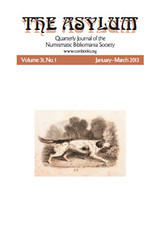 W. David Perkins - Key Public Auction Sales and Fixed-Price Lists:
Early United States Silver Dollars, 1794-1804
W. David Perkins - Key Public Auction Sales and Fixed-Price Lists:
Early United States Silver Dollars, 1794-1804
George Kolbe - Reminiscences of a Numismatic Bookseller 1
Elizabeth Hahn - Never Judge a Numismatic Book by Its Cover!
David F. Fanning - The 1893 Frossard & Hayes
P. Scott Rubin - The 1851 Dr. Lewis Roper Collection
Joel J. Orosz - Book Review (The Reference Library of a Numismatic Bookseller)
Wayne Homren - Book Review (The Private Sketchbook of George T. Morgan, America's Silver Dollar Artist)
LYN KNIGHT OFFERS SULLIVAN 2 COLLECTION OF BANK HISTORIES
The "Sullivan 2 Collection" of US State and Individual Bank Histories will be sold during the Lyn Knight Auctions Memphis Paper Money Show, Session 6 Closing Wednesday, June 19 online. The catalogue can now be viewed online. The bank history lots are offered within the national bank note sections divided by state. The collection includes 367 different bank histories of which only 17 appeared in the original "Sullivan 1 Collection" offered by Currency Auctions of America in the Fall of 2000 which included 903 volumes.
After the original collection was sold in 2000, I continued to collect bank histories with a focus on those I was unable to acquire during my first 15-years of collecting. With 28-years years of bank history collecting experience and the pending publication of my Bibliography of United States Bank Histories pending this summer, it was time to disperse this collection for others to enjoy. Important offerings include:
- Cross, Ira B. Financing an Empire: History of Banking in California. 4 vols. Chicago: S. J. Clarke Publishing Co., 1927. Deluxe - Decorated Cloth
- Aldrich, Clara Elizabeth: The History of Banking in Idaho. c.1940.
- Smith, D.G. Banks and Banking in Tazewell County, Illinois During the Nineteenth Century. Perkin, IL: c.1920. Tall Folio - Typed Manuscript - 12 leaves.
- Chadbourne, Walter W. A History of Banking in Maine, 1799-1930. Orona, ME: University of Maine, 1936. ix, 211 pp. Hardbound.
- Wendell, Emory., ed. Wendell's History of Banking and Banks and Bankers of Michigan: a Concise History of Banking Operations From the Earliest Time to the Present, with Detailed Accounts of Michigan Banking History. 2 vols. Detroit: Press of Winn & Hammond, [c. 1900]. Full brown morocco leather.
- Huntington, Charles Clifford. A History of Banking and Currency in Ohio Before the Civil War. Columbus: Fred J. Heer, 1915. 312 pp.
- Holdsworth, John Thom. Financing an Empire: History of Banking in Pennsylvania. Edited by John S. Fisher. 4 vols. Chicago, 1928.
- Carlson, Avery Luvere. A Monetary and Banking History of Texas From the Mexican Regime to the Present Day, 1821-1929.
- Hopkins, Ernest J. Financing the Frontier: A Fifty Year History of the Valley National Bank AZ, 1899-1949. Deluxe Leather bound edition
- 70th Anniversary: the Live Stock National Bank of Chicago, Chicago, Illinois, 1938.
- Pease, Zephaniah W. The Centenary of the Merchants National Bank, MA, 1925. Deluxe edition in full leather.
- Cox, Bruce K. History of the Private, State and National Banks of Gogebic County, Michigan, 1886-1984. Hardbound – One of Five Copies Bound with Blue Title Page.
- Huntington, George. Robber and Hero: Story of the Raid on the First National Bank of Northfield, Minnesota, by the James-Younger Band in 1876. 1895
- Amoskeag National Bank, NH and Safe Deposit Vaults, 1893.
- Fauber, J. Everette, Jr. An Architectural and Documentary Study the Bank of Alexandria, Fairfax and Cameron Streets - Alexandria, Virginia, 1974.
To view the sale catalog, see: new.lynknight.com/Browse_Auctions.Asp?CSID=338
NEW BOOK: PRIVATE NOTES AND COPPER COINS OF URUGUAY (1867 - 1871)
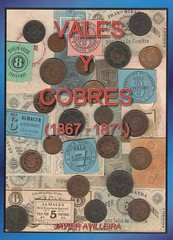 The book is available in Mercado Libre (the local Ebay auction site):
articulo.mercadolibre.com.uy/MLU-408482043-vales-y-cobres-1867-1871-novedad-numismatica-48-p-avilleira-_JM
The book is available in Mercado Libre (the local Ebay auction site):
articulo.mercadolibre.com.uy/MLU-408482043-vales-y-cobres-1867-1871-novedad-numismatica-48-p-avilleira-_JM
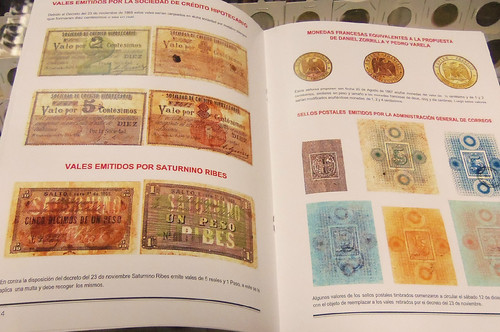
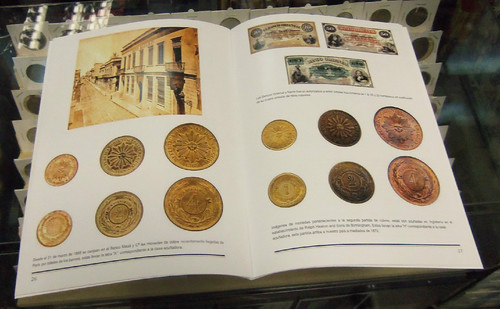
To order the book on eBay, see: www.ebay.com/itm/ws/eBayISAPI.dll?ViewItem&item=171054569172#ht_500wt_732
BOOK REVIEW: JOHN J. FORD AND THE FRANKLIN HOARD
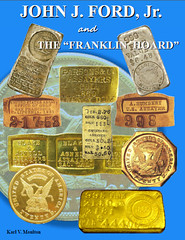 Karl V. Moulton's Ford/Franklin book was recieved this afternoon (Monday), shipped media mail, signature required from Congress AZ. I'd ordered it at $250 pre-publication price Jan 14 right after previewing the prepared manuscript at Orlando FUN.
Karl V. Moulton's Ford/Franklin book was recieved this afternoon (Monday), shipped media mail, signature required from Congress AZ. I'd ordered it at $250 pre-publication price Jan 14 right after previewing the prepared manuscript at Orlando FUN.
Well-packed although I wonder if the thin shrink wrap rather than a plastic bag will keep the book safe from the irregular Midwest wet weather. 8 lbs and almost as hefty as QDB's 10 lbs Gold Rush history book and just about as thick but slightly smaller in dimensions. Binding adequate if book is handled properly. I thought it a bit slight until I compared it with QDB's slightly larger Gold Rush book and noted the binding similarity. A dust cover to support the massive book would have been nice but would have added considerable expense assuming the printer could even have provided one.
Profusely illustrated and the numerous excellent plates dominate the book although there is plenty of fascinating text . Some interesting facts immediately stand out in casual perusal such as Paul Franklin serving as a US Army tower machine gunner at Dachau concentration camp while guarding German prisoners of war and meeting a imprisoned German dentist who put him on the track of making gold forgeries.
Those readers who knew John Ford and tend to be older will be pleased by the size of the text and the ease of reading the numerous often confidential Ford correspondence .
Money well spent - indeed I'd gladly pay $350 for it which may be the post publication price - I dunno. . Only the impending Long Beach coin show prevents me from diving into the volume this week. It appears to be a fascinating read.
Accompanying the book was a mint condition Henry Clifford 1982 Bowers & Ruddy auction catalogue.
At first I thought that perhaps the auction catalogue (of which I already have several copies ) was to keep the massive book from damage in shifting within in the shipping box but it then dawned on me that it is a cross-reference to the book as some of the fantasies referenced in the book were sold in the 1982 Clifford sale.
I knew Henry Clifford personally and visited him at his downtown LA law office and Rose Bowl area Pasadena home. I personally attended the Henry Clifford sale in Los Angeles in 1982 and sat to the right rear of JJF in the audience. John sat in the left front row right next to an elderly (80's?) well-dressed petite man whom JJF appeared to be advising during the sale. This elderly man bought nearly all or all of the questionable ingots and pioneer gold pieces in the sale, apparently at JJF's urging. It was quite obvious that JJF either wanted to keep the fantasies off the numismatic market or to "bury" them in another wealthy collector's collection .
To read an earlier E-Sylum article, see: AN UPDATE ON MOULTON'S FRANKLIN HOARD BOOK (www.coinbooks.org/esylum_v16n21a09.html)
TOKEN, MEDAL AND POLITICAL AUCTION
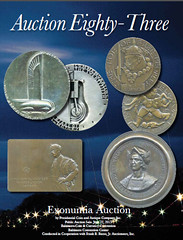
Presidential Coin & Antique Co., Inc.'s Auction Eighty-Three of Tokens, Medals and Political items will be held in conjunction with Whitman's Baltimore Coin & Currency Convention at the Baltimore Convention Center, June 20-23, 2013.
Hardcopies $6 - contact Joe Levine at Jlevine968@aol.com or view the catalog online here .
RICHARD G. DOTY, 1942-2013
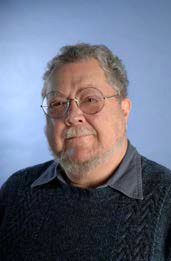 Richard (Dick) G. Doty, 1942-2013
Richard (Dick) G. Doty, 1942-2013
Smithsonian Curator
Richard. G. Doty, senior numismatic curator at the Smithsonian’s National Museum of American History, died on June 2, 2013 after battling lymphoma. Born in Portland, Oregon in 1942, Doty earned a B.A in history from Portland State University in 1964 then went on to receive a Ph. D in Latin-American Studies from the University of Southern California in 1968.
Until his death, Doty was the senior numismatic curator with the National Numismatic Collection at the National Museum of American History. After joining the staff in 1986, he revolutionized numismatic research by illustrating poignant human relationships reflected in the objects he thoughtfully analyzed. Doty shunned the rarified, traditional history told by many of his predecessors in favor of what numismatic artifacts could teach about the lives of everyday people. This lead to the publication of several major works including his most recent book Pictures from a Distant Country: Seeing America through Old Paper Money, published in 2013. Other popular books written by Doty include America’s Money, America’s Story (2008), The Token: America’s other Money (editor, 1994) The Macmillan Encyclopedic Dictionary of Numismatics (1982), Paper Money of the World (1977) and Coins of the World (1976).
Doty’s passion for telling stories about the lives of people led him to devote thirteen years of his life in pursuit of understanding how inventor and minter Mathew Bolton pioneered the use of steam power to make coins and then spread his technology around the world. This research led to Doty’s ground-breaking work The Soho Mint & the Industrialization of Money, published in 1998. Recognized as an authority in minting technology and the analysis of numismatic collections, Doty’s research was funded by grants from the National Endowment for the Arts, the National Endowment for Humanities and the Smithsonian Institution, among others that supported the dissemination of his ideas.
Prior to joining the Smithsonian, Doty worked at the American Numismatic Society in New York City from 1974-1986 where he served as Curator of the Modern Coins and Currency Department.
Doty began his professional career as a teacher. From 1967-1970 he was an Assistant Professor of United States and Latin History and Studies at Central College, Pella, Iowa. He also served as an Assistant Professor of Latin American and World History, York College, City University of New York (1970-71) and an Assistant Professor of United States and Latin American History at the University of Guam (1971-73).
Doty received numerous honors and awards during his prolific career, most notably a Fulbright Fellowship to the University of Madrid, Spain; a Mexican Government Fellowship for study in Mexico City and Guadalajara; the Del Amo Foundation Fellowship for research in Spain, the Millennial Award Medal of the Royal Numismatic Society and the Huntington Award from the American Numismatic Society and the Lifetime Achievement Award from the American Numismatic Association.
Doty was the founding President of ICOMON, the International Committee for Money and Banking Museums. He advocated for the importance of numismatic collections in society—as tools for teaching world history and important artifacts of material culture deserving of preservation and analysis.
As one of the world’s leading numismatists, Doty will be remembered for his irascible humor and the belief that by examining everyday life and deeds of ordinary people we can discover extraordinary history . He leaves his wife, Cindi Roden, and an international community of friends and colleagues.
MORE TRIBUTES TO RICHARD DOTY
Bill Fivaz writes:
We will all mourn this loss...we must also remember that Death is not putting out the light. It is only extinguishing the candle because the dawn has come.
Dave Lange writes:
Very sad news indeed. Dick was always a most gracious and helpful colleague whenever I required his assistance in numismatic matters. I'm attaching a photo from a particularly memorable occasion in 1996 when he hosted me and then-NGC grader Jeff Isaac as we were at the NNC studying the characteristics of early proof gold coins. Dick interrupted his regular work to bring us whatever coins we sought to examine, including the unique 1849 double eagle in gold and the two 1877 half union patterns in gold.
I'll always remember his generous nature and his unfailing contributions to numismatics.

Lange & Isaac with Doty 1996
Saul Teichman writes:
Truly a sad day. I cannot begin to tell everyone how helpful he and Doug Mudd were when I first started to setting up the uspatterns.com website. He will be missed.
Steve Bishop writes:
I never met Dick, but I wish I had. The next best thing is that I just received "Pictures From a Distant Country", and even though I haven't read it yet, a quick glance showed me that it will become a permanent part of my library. I don't remember the last time I saw the numismatic collection at the Smithsonian, but I'm going to make a point of visiting in honor of Dick.
Stephen Pradier writes:
So sorry to hear of Richards passing. I got to talk with him on several occasions before I moved from Northern Virginia regarding numismatic books in general and he had been very helpful to me in acquiring some books I was interested in. It is hard to believe that he is gone now.
Jim Downey writes:
I am also saddened by the passing of Dick Doty. I only met him on one occasion -- at the ANA convention in Milwaukee -- but he contributed greatly to my interest in numismatics. As an 8 year old in 1976 I bought a copy of his book Coins of the World from Scholastic. It was the first numismatic book in my library and one that I still have. His book sparked my interest in the hobby. I thanked him for that and explained the role his book played in my numismatic life. He told me that he was touched to have had such a tremendous influence on someone he had never met.
Georges Depeyrot writes:
I met Richard in Paris in January 1986 when he took part at the conference I organised on "Rythmes de la production monétaire" and we add a nice dinner at home. I saw him again in 1990 when i was visiting scholar at the American Numismatic Society. I made a jump to Washington to visit him. He was a outstanding numismatist. I planned to invite him last May in Madrid for our DAMIN meeting but he was not sure to be able to come due to the treatment, but he was enjoying to participate to the next conference in Copenhaguen on the mint production in 19th c.: e was the best specialist of the Soho mint. It is really a pity.
David T. Alexander writes:
What a wonderful series of tributes to a remarkable man and an outstanding numismatist. Isn't it wonderful that these tributes contradict Shakespeare's often quoted blurb, "the evil men do lives after them, the good is oft interred with their bones." Emphatically not the case here, as we see and read.
Eric Schena writes:
I wish I had gotten to know Dick sooner than I had - one of my favorite places when I was younger was the National Numismatic Collection and spent many an hour there. His writing was top notch and his contributions to the field are immeasurable.
Doug Mudd writes:
Great issue on a sad subject. Dick was a great mentor, colleague and friend. He will be missed - not least for his humor. He was cheerful and positive right to the end. Thank you for giving people the opportunity to express their feelings about him.
Ken Potter writes:
Very sad news on Richard Doty. I never had the pleasure of meeting him but his reputation was well known to me for what seems my lifetime and he was a household name. As a lymphoma survivor myself if brings tears to my eyes whenever one of my fellow lymphomians (not really a word) passes. So sad.
Carl Honore, M.A. writes:
Dick and I were close friends since he joined the Smithsonian as curator in 1987. He and I worked together for ten years as I assembled my exhibit for Portland ANA in 1998. Most recently he and I worked together on a possible water power mint design to strike the millions of heavy 5 Kopek pieces at Kolyvan and Ekaterinberg in Russia. We also had long discussions on the subject of theology. Dick was one hell of a partner. My first prize for my Portland exhibit is as much his as mine.
Peter Gaspar writes:
Shock, surprise and sadness were the reactions to the news of Dick Doty's death that I shared with so many others who opened The E-Sylum this Monday. I had known Dick since the 1970s, and while our contact was intermittent, we shared many interests.
In March I emailed him to ask whether he had been accurately quoted in a preview of an important sale of German bracteates. His encyclopedia of coinage described a die-making technique for these broad thin pieces that I considered unlikely.
Dick immediately replied that if he had written in his book what was attributed to him, he was probably wrong. I could hear the enthusiasm and unquenchable curiosity in his voice when he wrote "MAN, do I wish we could have been there at the time!" He ended by sharing a surprising finding about the striking of Papal medals in the 15th century - he described it as "way cool!".
In that message, he mentioned his lymphoma, which he said was going away. He sounded so vigorous and involved with his work that Monday's news was hard to believe.
I just wanted to join the contributors to your special issue in expressing our appreciation of Dick Doty. We will not see another like him.
In an article published Thursday on CoinUpdate, Michael Alexander writes:
I had met Richard formally on the day I had the pleasure of speaking with him during the tour of the St. Gaudens $20 gold coin which made stops in several European cities last year. I had seen Richard many times before that, always in demand – his knowledge and expertise literally on tap and ready to share what he knew about our beloved activity.
I last saw Richard in Berlin during the World Money Fair and as always, on the go but kindly asking after my projects and activities. Richard was always very willing and keen to pass on his acute understanding and experience of numismatics to myself and many of my colleagues, offering his insight and opinion which was so eagerly sought after.
The Smithsonian have issued an obituary for Richard, I’d like to share it with you as it captures so much of the man - his many published contributions and his love of Numismatics as well as the sentiments of those who admired Richard, he will be very missed indeed but, I am confident he will be well remembered.
To read the complete article, see: Richard G. Doty, 1942-2013 (news.coinupdate.com/richard-g-doty-2013/)
Bill McKivor writes:
I'm going to miss Dick terribly, he was one of my best friends. Right up to a couple days before he passed away we were making plans for a trip in 2014, when he was cured----though I think we both knew it would not happen. Damn!
Ron Abler writes:
I only met Dick once, when he arranged for me to study the Centennial medals in the National Numismatic Collection. Despite being busy that day, he was the soul of hospitality.
Mike Metras writes:
The world of numismatics had an amazing eye and mind in Dick. He was a light shining brightly on our hobby.
Dick's wife Cindi adds:
His wish was to be cremated and his ashes scattered into the ocean off the coast of Wales.
To read the earlier E-Sylum article, see: E-SYLUM READERS REMEMBER RICHARD G. DOTY (www.coinbooks.org/esylum_v16n23a03.html)
To read the more comments on the Collector's Universe message boards, see: forums.collectors.com/messageview.cfm?catid=26&threadid=890578
MORE ON KELLY'S COINS AND CHATTER
Dan Hamelberg writes:
I checked my Kelly's Coins and Chatter, and the list in the recent E-Sylum is essentially correct. The only correction I found was in Vol. 2, the September issue is missing. As an addition, I have a 1949 issue of Coins and Chatter that appears to have been an insert for Hobbies Magazine. The format for the insert follows the same 4 page format of most all the regular issues. There is no date on the insert, but the latest date coin advertised is a 1949 commemorative.
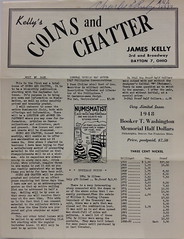 445 Kelly, James. KELLY’S COINS AND CHATTER. A complete set of Kelly’s house organ, 1948–61, plus ten affiliated auction sales. 4to, self-covered as issued. Folded for mailing, else fine copies. (200.00)
445 Kelly, James. KELLY’S COINS AND CHATTER. A complete set of Kelly’s house organ, 1948–61, plus ten affiliated auction sales. 4to, self-covered as issued. Folded for mailing, else fine copies. (200.00)
A complete set of this lively house organ. Kelly’s publication schedule was erratic over the course of Coins and Chatter’s existence, with some volumes comprising twelve numbered issues, while others consisted of as few as two. His numbering scheme often went askew, making it difficult to determine what exactly makes up a complete set. To complicate matters further, he published occasional unnumbered ANA issues, as well as ten auction sales that, while separate publications, were issued with the periodical.
This set includes the following: Vol. 1 (1948), Nos. 1–7, complete. Vol. 2 (1949), Nos. 1–11, complete. Vol. 3 (1950), Nos. 1–11, plus a special ANA edition, complete. Vol. 4 (1951), Nos. 1–12 (10 was skipped), complete. Vol. 5 (1952), Nos. 1–10 (8 was skipped), complete, plus auctions 1, 2, 3, 4/5, and 6. Vol. 6 (1953), Nos. 1–9 (2–3 were skipped), plus a special ANA edition, complete, and auctions 7 and 8. Vol. 7 (1954), Nos. 1 and 2, complete. Vol. 8 (1955), Nos. 1–6, complete. Vol. 9 (1956), Nos. 1 and 2, complete. Vol. 10 (1957), Nos. 1–12, complete (the first three numbers are misidentified as being from Vol. 7). Vol. 11 (1958), Nos. 1–8, complete. Vol. 12 (1959), Nos. 1–12, complete, plus two unnumbered auctions. Vol. 13 (1960), Nos. 1–12, complete. Vol. 14 (1961), Nos. 1–6, complete.
In the interest of accuracy, it has to be mentioned that an issue of Coins and Chatter not here present was distributed in the March 1949 issue of Hobbies magazine: whether this is necessary for a complete set is subject to debate.
Though a modest publication, Kelly’s Coins and Chatter provides an excellent feel for numismatics during the time period, and their seemingly ephemeral nature meant that few issues were saved, so that significant runs are infrequently offered. Ex Del Bland library.
Tom Wetter writes:
These are the types of questions that we are hoping to address on the NBS Wiki. The entry for this item has not been completed but most of the research has. A complete set consists of 127 issues along with ten auctions sales and an unnumbered ANA issue. The volumes are broken down as follows:
Volume 1 (1948) Consists of 7 issues; numbers 1-7
Volume 2 (1949) Consists of 11 issues; numbers 1-11
Volume 3 (1950) Consists of 12 issues: numbers 1-12
Volume 4 (1951) Consists of 11 issues; numbers 1-9, 11-12. Number 10 was not used. Special ANA issue.
Volume 5 (1952) Consists of 14 issues: numbers 1-7, 9, 10. Number 8 was not used. Auctions 1, 2, 3, 4/5, 6
Volume 6 (1953) Consists of 10 issues; numbers 1, 4-9. Numbers 2 and 3 were not used; Auctions 7, 8. Unnumbered ANA issue.
Volume 7 (1954). No volume designation. Consists of 2 issues; 1-2
Volume 8 (1955) Consists of 6 issues; numbers 1-6
Volume 9 (1956) Consists of 2 issues; numbers 1-2
Volume 10 (1957) Consists of 12 issues; numbers 1-12 with numbers 1-3 having a Volume 7 designation
Volume 11 (1958) Consists of 8 issues; numbers 1-8
Volume 12 (1959) Consists of 14 issues; numbers 1-12; Auctions 9, 10
Volume 13 (1960) Consists of 12 issues; numbers 1-12
Volume 14 (1961) Consists of 6 issues; numbers 1-6
David Gladfelter writes:
James Kelly’s dating and numbering “system” for his periodical Coins and Chatter is what my Pennsylvania Dutch ancestors would describe as “all verhoodelt”. He published 127 issues on an irregular schedule from 1948 to 1961, including 119 newsletters and 8 mail bid auctions.
Remy Bourne’s tally is correct, according to Michael Sullivan who dug into this problem and reported the results in the Summer 1993 issue of The Asylum. Dave Hirt has ‘em all, except for the 8 auctions, which were sent to Kelly’s subscribers along with the newsletters. In the May 1952 issue Kelly wrote that beginning with that issue “we are starting a monthly COINS AND CHATTER Auction Sale. The listing for the first of these Sales, as well as the April issue of COINS AND CHATTER, is enclosed.”
The newsletter does contain interesting factual tidbits in with the coin advertisements, but little if any original research. An example taken at random from the February 1951 issue is captioned “Pine Tree Shilling”. It’s two paragraphs long and concludes with the sentence, “Hawthorne’s tale of the dowry given to Hull’s daughter Hannah – her weight in gold and silver, is therefore probably based on fact.” The periodical is not indexed.
To read the earlier E-Sylum article, see: QUERY: KELLY'S COINS AND CHATTER SET (www.coinbooks.org/esylum_v16n22a09.html)
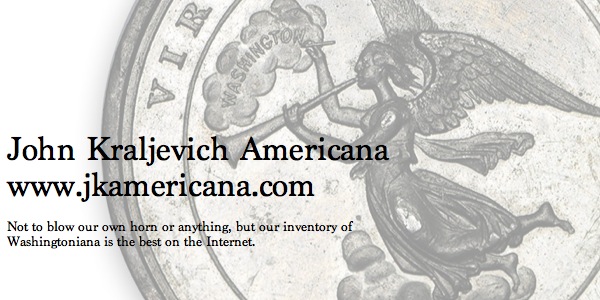
HENRY VOIGT'S PERSONAL ACCOUNT BOOK
Len Augsburger writes:
I didn't find the first Voigt account book at the Hagley, what I found was a personal account book of Voigt, between Voigt and Eckfeldt, and between Voigt and Reich. Sample images attached.
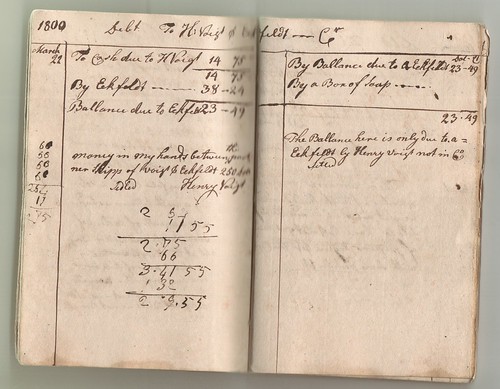
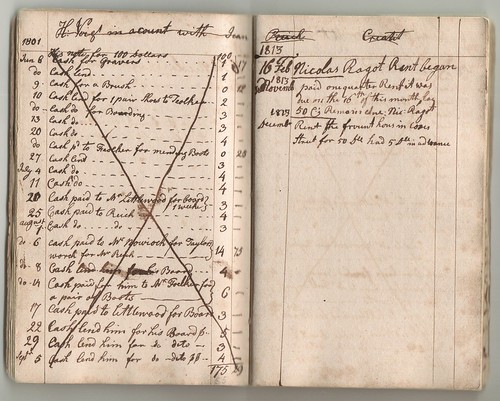
To read the earlier E-Sylum article, see: THE HAGLEY MUSEUM & LIBRARY, WILMINGTON (www.coinbooks.org/esylum_v16n22a11.html)
NOTES FROM E-SYLUM READERS: JUNE 9, 2013
Coin Seizures in Egypt
Dan Demeo writes:
About Arthur Shippee's article of coin seizures in Egypt: The coin pictured appears to be a common Ptolemaic bronze coin, I only see one eagle, but they come with two as well. And I guess it is unique, as are all ancient coins, since they were not made with the precision of modern coins. But gilded? How about patinated? I don't see any gold. Value, maybe a couple hundred dollars, not the kind of money for which you want to do time. There are Ptolemaic gold coins, made of gold, not just gilded, worth much more. The other part of the story--bringing in some Ottoman coins is a crime in Egypt? Maybe not declaring them? It sounds as if the story has been translated to English and may have lost some content in translation.
To read the earlier E-Sylum article, see: COINS SEIZED AT CAIRO AIRPORT (www.coinbooks.org/esylum_v16n22a27.html)
Mike Metras' Start in Collecting
Mike Metras writes:
I have to respond to Cliff Mishler’s story about the Zanzibar coin beginning his interest in collecting. In 1955 when I began collecting it was an entirely different 1900 quarter I got on my paper route that sparked my beginning interest collecting.
But a short time later I acquired a 1330 Moroccan 5 maumas) from a source long lost to my memory. It was an Arabian date, like Cliff’s. I was totally intrigued. I was hooked. I had a coin that was 700 years old! It was a while before I discovered the Arabic dating meant that it was “only” 1912. But you know, I can still feel that feeling of that ‘old’ coin almost 60 years ago. I really can. It hooked me on foreign collecting as the 1900 did on American collecting.
And now almost 60 years later, I am selling the stash of many years of gathering back to real collectors on eBay and re-living the joy of every coin as I photograph and write it up. It is time to pass my stewardship on to other collectors. What a hobby!
To read the earlier E-Sylum article, see: TANZANIAN COIN INTRODUCED CLIFFORD MISHLER TO NUMISMATICS (www.coinbooks.org/esylum_v16n22a04.html)
Query: Token Size Listing Sought
Tom Sheehan writes:
In the last E-Sylum in the article on Chubbuck there was a reference to a token size 20. I know I have seen a listing somewhere that listed all of the various sizes in that system and converted it to either inches or millimeters. Can you or one of the E-Sylum readers help out here?
To read the earlier E-Sylum article, see: S. W. CHUBBUCK, NUMISMATIST (www.coinbooks.org/esylum_v16n22a05.html)
ANA Peter Max Print's Donor Identified
 Regarding the Peter Max poster commissioned by Kagin's for an ANA auction catalog, I asked who was Vincent Van Rottkamp, who donated a copy of the poster to the American Numismatic Association.
A web site visitor writes:
Regarding the Peter Max poster commissioned by Kagin's for an ANA auction catalog, I asked who was Vincent Van Rottkamp, who donated a copy of the poster to the American Numismatic Association.
A web site visitor writes:
Vincent Van Rottkamp was Peter Max's agent.
To read the earlier E-Sylum article, see: MORE ON THE PEACE DOLLAR DRAWING BY PETER MAX (www.coinbooks.org/esylum_v16n11a08.html)
EL SITIO NO. 7 PUBLISHED
 “El Sitio” Nº 7 contains seven interesting numismatic articles:
“El Sitio” Nº 7 contains seven interesting numismatic articles:
1) An interesting story from the Angel of the Madonna Sixtina used in one Uruguayan banknote, by Javier Avilleira.
2) Numismatics as a dating tool in archaeology, by Eduardo Cicala.
3) The tokens of the Ranch Tornero in the department of Florida in Uruguay, by Horacio Morero and Mario Sánchez.
4) A document about the Lima Mint, by Gustavo Pigurina.
5) Year 1896 banknotes of the Banco de la República that never circulated , by Daniel Fernández Calvo.
6) The ship that brought Jules Rimet and the 1930 World Cup, by Daniel Padula.
7) Another thesis about the origin of the symbol “Pesos”.
“El Sitio” Nº 7 also comments an exposition of Roman coins, by Carlos Rucks, and the presentation of a new book: “Vales y Cobres (1867 - 1871)” (“Private Notes and Copper coins (1867 - 1871”)) by Javier Avilleira.
THE BOOK BAZARRE
QUERY: HOW DID THE SS CENTRAL AMERICA TRAVERSE SOUTH AMERICA?
J. Hill of Kentucky writes:
How did the SS Central America make it to the Atlantic from the Pacific? Articles repeatedly mention the ship headed to Panama. What's interesting is that this was 1857. The Panama Canal did no open until August 15, 1914. Prior to that they had a cross country railroad. If it went around the tip of South America, why do articles keep mentioning Panama which seems to me to be insignificant?
Bob Evans writes:
The S.S. Central America was never in the Pacific.
The Panama Route consisted of two separate steamship lines, and a railroad across the Isthmus of Panama (completed in 1855.) The ships of the United States Mail Steamship Company, including the S.S. Central America made voyages between New York and the American port of Aspinwall, on the Caribbean coast of Panama. The ships of the Pacific Mail Steamship Company took care of travel between Panama City, on the Pacific side of the isthmus, and San Francisco. The Panama Railroad, following a route roughly the same as the later canal, took care of the crossing between the oceans.
Steamships were arguably one of the two great technological advancements of the age. For the first time in human history, steamers made it possible to schedule fairly long-distance travel at sea. Ideally, the two steamship lines scheduled their departures from New York and San Francisco so that they arrived on opposites coasts of Panama on the same morning, the railroad could complete the crossing in a few hours, and travelers could be northbound on another ocean the evening of the same day.
Of course, disruptions could occur, but that was the idea.
The ill-fated New-York-bound passengers on the S.S. Central America had departed San Francisco on the Pacific Mail's S.S. Sonora on August 20, 1857. Generally, a steamer left San Francisco on the 5th and 20th of every month. The steamer lines generally kept two, sometimes three, steamships on a rotating schedule to maintain their service, which was considered very reliable, and thus carried the US Mail. It is interesting to note that this was also the fastest means of communication between the eastern states and California prior to the completion of the transcontinental telegraph in 1862.
The S.S. Central America completed 43 voyages between New York and Panama and back, beginning in November, 1853. It was lost on the homeward leg on its 44th voyage, sinking on September 12, 1857.
To read the earlier E-Sylum article, see: THE S.S. CENTRAL AMERICA'S LOST GOLD (www.coinbooks.org/esylum_v16n22a16.html)

WEST POINT MINT CELEBRATES 75TH ANNIVERSARY
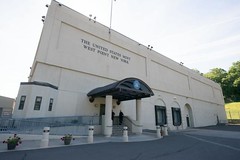 The West Point Mint is celebrating the 75th anniversary of its 4-acre plant, and the Daily News got a rare look Wednesday at the upstate facility that holds $80 billion in precious metals.
The West Point Mint is celebrating the 75th anniversary of its 4-acre plant, and the Daily News got a rare look Wednesday at the upstate facility that holds $80 billion in precious metals.
Security is tight at the facility about 90 minutes north of the city. Its 150 employees go through rigorous screenings every day to make sure they are metal free when they leave — and that includes checking the fillings in their teeth.
“We know how many times you have been to the dentist,” said Tom Dinardi, the deputy manager. “They’ll find anything. You won’t get through on the way out.”
 The workers spend their days stamping American eagles on big silver dollar coins, by far the most popular.
The workers spend their days stamping American eagles on big silver dollar coins, by far the most popular.
Last year they sold 45 million — a nice jump from the 8 million sold in 2007.
They also labor over fancy gold and platinum collectible coins that can go for $1,700 a piece, said Dinardi.
To read the complete article, see: West Point Mint, with $80 billion in precious metals, celebrates 75th anniversary (www.nydailynews.com/new-york/west-point-mint-celebrates-75th-anniversary-article-1.1364535)
THE TOWER OF LONDON'S NEW ROYAL MINT EXHIBIT
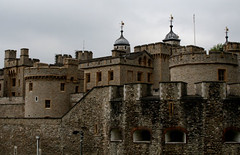 There is a new treat for those of you who pride yourselves as both coin fanatics and Anglophiles… after a lengthy absence of more than 200 years, give or take a year or two, the Royal Mint has returned to London! Well…don’t any of you get too excited – they’re not producing the coinage of the realm there, but they have indeed returned in style. A new exhibition has been opened just last week (24th May) and it is for many who have so far attended – myself included, the Mint’s triumphal return to their spiritual home – and right where they belong!
There is a new treat for those of you who pride yourselves as both coin fanatics and Anglophiles… after a lengthy absence of more than 200 years, give or take a year or two, the Royal Mint has returned to London! Well…don’t any of you get too excited – they’re not producing the coinage of the realm there, but they have indeed returned in style. A new exhibition has been opened just last week (24th May) and it is for many who have so far attended – myself included, the Mint’s triumphal return to their spiritual home – and right where they belong!
Where does one begin to tell the tale of one of the most famous Mints in the world? Although a Mint in London has been active since the 800’s, today’s Royal Mint claims a continual history which dates back to the 1100’s, though it wasn’t referred to the Royal Mint until many, many years later. This particular Mint in London was just one of many dotted around England. It wasn’t until the 1270’s that King Edward I moved the workings of London’s Mint within the Tower Walls. The King took this decisive action as it was deemed that England’s coins at the time were worn, clipped, debased or intentionally damaged. He ordered the country be re-coined and it was in this safe and secure location that the process of introducing new coins was carried out.
In 1696, Sir Isaac Newton, famed mathematician and physicist took up the post of Warden of the Mint, this post was responsible for investigating cases of counterfeiting. He later held the office of Master of the Royal Mint from 1699 until his death in 1727. He is credited with updating the Mint’s facilities and transforming production methods which resulted in substantially greater numbers of coins at a savings in overall costs.
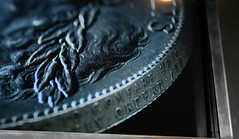 Some of the coins displayed in the exhibition include an excellent example of an Edward I silver groat, minted between 1279-1307. A Gold trial plate from an Angel of Henry VIII, minted 1542. An Elizabeth I gold Half-pound, minted from 1591-94. Queen Elizabeth I was celebrated for restoring Tudor currency after her father’s reign. The queen ordered all old coins to be brought to the Mint, melted down and re-made into new, purer coins with her portrait. The queen described the measures as ‘bitter medicine’. Of particular interest is a Commonwealth unite - equaling 20 shillings minted in 1649 and a silver crown minted in 1658. Oliver Cromwell refused to be called king and the official coins produced during the Commonwealth did not feature a picture of any ruler. However, on this coin, designed by Chief Engraver Thomas Simon, Cromwell was shown as an Emperor.
Some of the coins displayed in the exhibition include an excellent example of an Edward I silver groat, minted between 1279-1307. A Gold trial plate from an Angel of Henry VIII, minted 1542. An Elizabeth I gold Half-pound, minted from 1591-94. Queen Elizabeth I was celebrated for restoring Tudor currency after her father’s reign. The queen ordered all old coins to be brought to the Mint, melted down and re-made into new, purer coins with her portrait. The queen described the measures as ‘bitter medicine’. Of particular interest is a Commonwealth unite - equaling 20 shillings minted in 1649 and a silver crown minted in 1658. Oliver Cromwell refused to be called king and the official coins produced during the Commonwealth did not feature a picture of any ruler. However, on this coin, designed by Chief Engraver Thomas Simon, Cromwell was shown as an Emperor.
For American coin enthusiasts, on display is a beautiful Countermarked American Liberty dollar dated 1799. This coin actually circulated in Great Britain due to some adverse circumstances. By 1797, war with France had left England’s gold stocks perilously low. To avert financial disaster, the Mint began to counter-stamp a small cameo portrait of King George III on several foreign coins, including American dollars and French francs, to make them legal English currency.

The exhibition focuses not only on the actual production of coins themselves but, it also gives us a great insight about the people who worked there, their lives and daily routine. Cleverly re-created with projections and sound recording, Mint workers are brought to life as we’re transported to parts of the production floor and are introduced to the craftsmen, the tools and procedures used to make the coin of the realm. Much of the displays are interactive and “hand’s on” and very youngster friendly with video displays and touch-screen participation.
To read the complete article, see: The Royal Mint Returns to the Tower in Style! (news.coinupdate.com/the-royal-mint-returns-to-the-tower-in-style-2004/)
THE BOOK BAZARRE
GREAT FIND: FIRST SUPERMAN COMIC BOOK WAS USED AS INSULATION
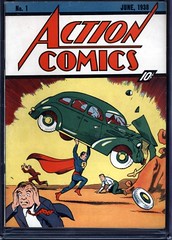 A Minnesota man stumbled upon pages from a rare copy of Action Comics #1 inside a wall of a home he was renovating — a find that is worth at least tenfold what he paid for the house itself.
A Minnesota man stumbled upon pages from a rare copy of Action Comics #1 inside a wall of a home he was renovating — a find that is worth at least tenfold what he paid for the house itself.
David Gonzalez, 35, of Hoffman, Minn., was busy tearing out insulation in the garage of a $10,100 fixer-upper he purchased, when the home renovator noticed old newspapers and comic book pages lining the wall last January.
Though he wasn't exactly a comic book fan, the discovery looked valuable. "I brought my wife's auntie to see the house and she got excited, she said oh, look, this is worth money,'" Gonzalez told the News by phone from Minnesota. "I said, I know, don't touch it, don't touch it,' and she kept grabbing it and grabbing it.
"Just leave it alone! Little pieces kept breaking off."
It took him several months, but Gonzalez tracked down a collectables trader in Tampa Bay named David Alexander and drove down to Florida to have the issue appraised. His grab of the issue from his wife's relative's hands ended up downgrading the value on a 10-point scale from 3.0 to 1.5, but the issue has already drawn a high bid of $113,111 on auction site comicconnect.com. The auction runs through June 11.
"Superman is the man, he's a hero," said Gonzalez, laughing. "It's so hard for anyone to fathom that, in this day and age, you could still discover a comic book that nobody has known about because this book was in a wall of a house for more than 70 years,"
"It's pretty miraculous that it even survived and it's only had one owner." A near-mint copy of Action Comics #1 leaped expectations in a single bound and sold for $2.16 million in 2011.
To read the complete article, see: Man finds priceless copy of Action Comics #1, first Superman comic book, hidden in walls of a house (www.nydailynews.com/entertainment/music-arts/man-finds-priceless-comic-wall-home-article-1.1352018)
FIRST-TIME METAL DETECTORIST FINDS ROMAN GOLD HOARD
 Wesley Carrington was using the most basic metal detector when 20 minutes into his first foray he found 55 gold solidus dating back more than 1,600 years.
Wesley Carrington was using the most basic metal detector when 20 minutes into his first foray he found 55 gold solidus dating back more than 1,600 years.
He had begun his search in woodlands near St Albans, Herts, after watching video clips on metal detecting on the online site YouTube.
Mr Carrington said "I just thought I would give it a go. I would say after about 20 minutes it beeped. I found a coin that was gold-coloured, with a Roman figure on it."
Days later he returned to the Berkhampstead shop where he had purchased his £135 metal detector and showed them his haul.
Shop owner David Sewell and business partner Mark Becher were "gobsmacked" when he produced the coins and asked what he should do with them.
Mr Sewell said: "He came to see us and we looked at it and thought: 'Is this a stunt?'".
They then contacted the local council's museum service and a further search of the site unearthed another 104 coins.
At an inquest in Hatfield yesterday, coroner Edward Thomas declared the find treasure trove and passed the matter to the British Museum to put an estimate on the items.
The value of the hoard, believed to be more than £100,000, will then be split between Mr Carrington and the landowner.
To read the complete article, see: I dug up £100,000 of gold the first time I tried metal detecting (www.express.co.uk/news/weird/405451/I-dug-up-100-000-of-gold-the-first-time-I-tried-metal-detecting)
THE BOOK BAZARRE
WILL AUSTRALIA ISSUE SCENTED BANKNOTES?
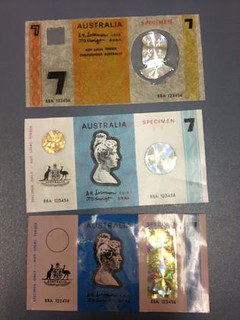 THIS image could be the first glimpse of a New Australian $7 banknote, infused for security purposes with Australia's national scent, the Wattle.
THIS image could be the first glimpse of a New Australian $7 banknote, infused for security purposes with Australia's national scent, the Wattle.
Inventors of the polymer plastic banknote, which is now used in 20 countries, the CSIRO, would not say if the note was real or an accurate hoax, adding fuel to rumours that Australia is about to add to its stock of $5, $10, $20, $50, and $100 plastic notes.
"The CSIRO is neither confirming or denying that it designed a $7 banknote or that it is infused with wattle scent for security reasons,'' a spokesman said.
The photograph was sent to The Advertiser by a government official in Canberra, where it has been circulating in an email with an official Federal Government email address which claims it is the "world's first scratch n' sniff banknote".
The notes could be a hoax, copycatting those who pretended the Canadian $100 polymer note released this week was infused with specially formulated maple syrup scent to stop counterfeiting. This has been denied by the Canadian government.
To read the complete article, see: Canberra rumour mill turns out Wattle-scented banknote (www.heraldsun.com.au/money/canberra-rumour-mill-turns-out-wattlescented-banknote/story-fni0cms4-1226656068728)
To read the earlier E-Sylum article, see: DO CANADA'S NEW POLYMER $100 BILLS SMELL LIKE MAPLE SYRUP? (www.coinbooks.org/esylum_v16n22a12.html)
ADOLPH'S LOVE TOKEN

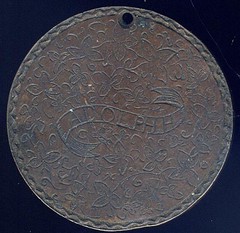
Gene Brandenburg writes:
From an estate I recently purchased, a historical "Love Token" on a Victorian large penny. Who knew Hitler had a secret love interest across the channel? Questions abound about this mystery 'englisch freundin'. Was her name Vicky? Did she like strudel? Could she goose-step? Did she harbor secret desires to invade France? This important numismatic discovery could change history as we know it (or maybe not...). I thought E-Sylum readers might enjoy this unusual 'leibesbeweis'.
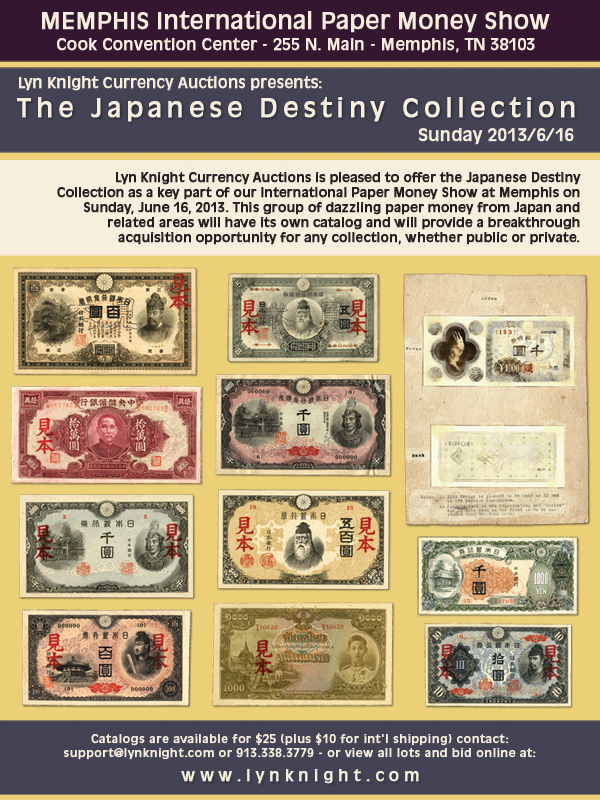
DAVE BOWERS ON DOTY'S 'PICTURES FROM A DISTANT COUNTRY'
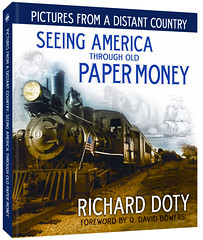 My first reaction after reading the manuscript for this book was, “Amazing that this has not been done before.” And then, What an incredible work this is!” After all, the vignettes on these notes describe American life in all its aspects. Railroad engines, cars, and tracks are depicted from the early days of that mode of transportation down to the 1860s, when trains became more sophisticated and complex. Canals, which preceded railroads in popularity, are well depicted. Not to be overlooked are stagecoaches, horse-drawn street cars, sidewheel steamships, and more.
My first reaction after reading the manuscript for this book was, “Amazing that this has not been done before.” And then, What an incredible work this is!” After all, the vignettes on these notes describe American life in all its aspects. Railroad engines, cars, and tracks are depicted from the early days of that mode of transportation down to the 1860s, when trains became more sophisticated and complex. Canals, which preceded railroads in popularity, are well depicted. Not to be overlooked are stagecoaches, horse-drawn street cars, sidewheel steamships, and more.
Buildings ranging from the United States Capitol (in various stages of construction) to city halls, to downtown commercial districts, to the structures that housed the banks that issued paper money, can be found in quantity. Scenes of American life—slaves picking cotton, Indians (Native Americans) contemplating the advance of the white man into their territories, blacksmiths, carpenters, people picking flowers, reading, farming, cutting wood—you name a subject and likely a detailed view of it can be found on a bank note.
While published illustrations in most early 19th-century books range from careless to detailed, most were created quickly. In contrast, the vignettes on the notes shown in this book are from copper or steel plates painstakingly engraved and with a wealth of minute detail. In a phrase, no finer illustrations could be found.
My own involvement with engraved vignettes on 19thcentury bank notes took place many years ago, in the 1950s. I found it curious that beautiful notes, often in color, were available on the market for just a few dollars each. There was a reason: no price guides or standard references existed, so few people were interested. Moreover, there was no way to tell whether a note was common or rare until one gained hands-on experience.
Today as I write these words the situation is far different. The Society of Paper Money Collectors has published books about the notes of a dozen or more specific states. James A. Haxby’s magisterial four-volume Obsolete Bank Notes 1782 –1866, issued in 1988, has served as a general guide, including prices. Now obsolete (no pun intended), the relative values in the Haxby study are still useful—perhaps if multiplied by 10 or 20 times!
A few years ago I spent an enjoyable time researching and writing Obsolete Paper Money Issued by Banks in the United States 1782–1866 for Whitman Publishing Company. My travels and search for information included visits to the National Numismatic Collection at the Smithsonian. Dick Doty has been a great host—whether deep inside a vault with priceless notes, or in the evening at a favorite restaurant where he regaled everyone with interesting numismatic tales and stories. I soon appreciated what a treasure trove the Smithsonian held.
With his background in history, writing, and curation, Dick is the ideal author for this book, tapping those treasures. As I mentioned, the wonder is that it hasn’t been done before. The answer must be that years of time, great talent, and access to a wide selection of notes are required, and few could measure up to this standard.
Far from being just a “picture book,” the text guides the reader through the development of bank-note engraving, advances in artistry, selection of subjects, and the circumstances of issue. Without a doubt, if you spend a weekend with Pictures From a Distant Country, you will have a good time—it indeed is a “good read.” You will appreciate the truly wide world of different and fascinating illustrations and, even without trying, you will become an expert. Along the way you will learn you live in the Distant Country. It is distant in time, not in location. A finer view of life in America in the early 19th century could not be imagined.
I anticipate that Dick Doty’s master work will be an essential addition to any numismatic library and, beyond that, to the library of anyone who appreciates and enjoys illustrations showing the development of the country in which we live. My congratulations.
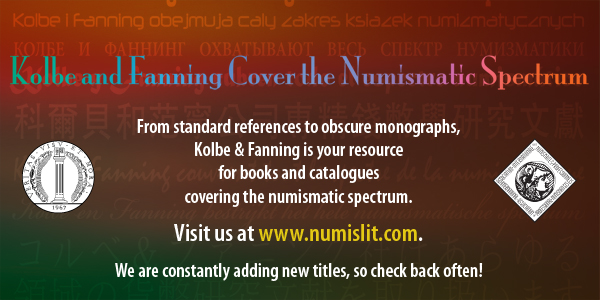
NATIONAL MUSEUM OF IRELAND EXHIBITS COIN HOARD
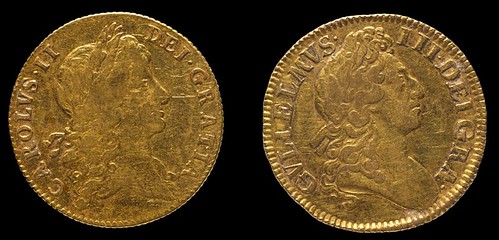
The earliest coin in the hoard on the left (Charles II- 1664)
and the latest coin in the hoard on the right (William III- 1701).
Jimmy Deenihan TD Minister for Arts, Heritage and the Gaeltacht formally opened the display of recently discovered 17th Century gold coins from Carrick-on-Suir. The hoard is on display in the National Museum of Ireland - Decorative Arts & History, Collins Barracks.
The hoard was discovered on 14th January 2013 by David Kiersey, Shane Comerford, Tom Kennedy, Shane Murray and Patrick McGrath during ground works being undertaken at Main Street, Carrick-on-Suir, Co. Tipperary. The families and close friends of the finders were invited to the Museum to witness the coins being placed on display for the general public. The coins are reported to have been “in a line together” in the ground and may have been wrapped and held together by some material which has not survived.
Speaking at the Museum Minister Deenihan thanked each of the finders, and acknowledged their honesty and civic responsibility in immediately coming forward to the relevant authorities and declaring the discovery.
"The finders of this important hoard did absolutely the right thing by calling the National Museum. On discovery of this treasure their immediate instinct was to ensure this collection could be saved for viewing by the people and for future generations, and they are to be thanked and acknowledged for this."
The find consists of 81 gold coins dating to the reigns of Charles II (1660-85), James II (1685-8), William and Mary (1688-94) and William III (1694-1702). There are 77 guinea and 4 half guinea coins present, with the earliest dating to 1664 and the latest to 1701. The Guinea was a British gold coin minted by the Royal Mint between 1663 and 1814. ‘Guineas’ were so-called because the gold used in making some of them came from Guinea, West Africa and they were minted in four denominations (a half, one, two and five).
The Carrick-on-Suir Hoard probably represents the accumulated wealth of a single family over a number of generations, and was collected in the period following the Cromwellian War down to the end of the decade following the Williamite War. It is not known why the hoard was hidden but it is possible that its wealthy Catholic owner may have considered it necessary to hide his portable assets in response to the imposition of the Penal Laws. Many other scenarios are possible and further research is being conducted to try to establish the historical background of the hoard.
To read the complete article, see: 17th century Carrick-on-Suir gold coin hoard goes on display at the National Museum of Ireland (artdaily.com/index.asp?int_sec=2&int_new=62996#.Ua6SJECNqXg)
FEATURED WEB PAGE: AN 1856 SAN FRANCISCO MINT VISIT
This week's Featured Web Page is suggested by Dave Ginsburg. It's an October 1856 article in Hutchings' California Magazine which described a visit to the San Francisco Mint. Thanks.On the north side of Commercial street, between Montgomery and Kearny, there stands a dark, heavy looking building, with heavy iron bars, and heavy iron shutters, to windows and doors; and high above, standing on, and just peering over a heavy cornice, there is a large American eagle; looking down into the building, as if he meant to see, and take notes, of all that is going on within, "and print 'em too."
At his back there is a small forest of chimney stacks, from which various kinds of smoke, and different colored fumes, are issuing. This building is the Branch Mint of San Francisco.
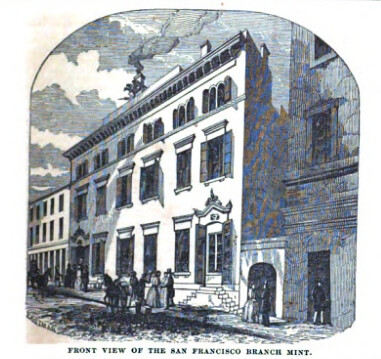
babel.hathitrust.org/cgi/pt?id=mdp.39015021556108
;view=1up;seq=158
